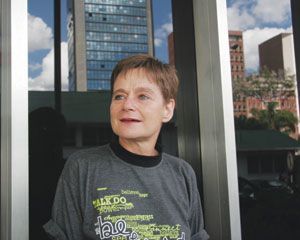
I’m loving training for the 20 Miler and in the past week have pipped my personal 10km best not once but twice, proving this is a sport that can be pleasingly age-defying!
Report by Rosie Mitchell
Last weekend I further redefined my notorious hyperactivity by; singing the final full rehearsal of The Messiah Friday night; working Saturday morning; swimming 1km; singing in the evening Messiah performance; running 25,5km in blazing heat early Sunday; then singing the Messiah again!
Expecting to be whacked Monday morning, I was annoyingly perky and not even stiff! I suspect I may be crossing the unseen threshold from enthusiastic runner to addict, as I had to restrain myself from running again Monday, but wisely gave the hard-working muscles a day to recover!
Harare Athletic Club (HAC) hosts the 42nd Europcar-Dendairy 20 Miler on December 2 2012, the top event on the annual running calendar. Established in 1949, HAC is Harare’s oldest running association and this is the third year that Europcar is flagship sponsor of the event. Dendairy is co-sponsor this year, with other sponsors, Rooney’s and Fuchs.
The men’s record has been held since 1991 by Paul Moqhali of Swaziland in a time of 1.42.30 and the ladies’ record since 1998 by Zimbabwean Debbie Lambourn in 2.07.19. At least 300 runners are expected and there is prize money in all categories.
The 16km + 16km relay has been re-introduced as a fun run and the race starts out on Shamva Road, climbs through Glen Lorne and ends at Old Georgians Sports Club.
Entry is US$20 and registration is at Old Georgians on November 30 from 5pm and December 1 from 11am to 4pm.
- Robbers pounce on Mukuru in Bulawayo
Keep Reading
Wetland crisis continues in Harare
On 27 July 2012, 26 wetlands (vleis) in Harare were gazetted as protected areas, but provision was not made for objections, so we now await the re-gazetting of this important new legislation, with amendments.
As we wait, the scramble to take advantage of the delay, and generalised confusion around wetland conservation legislation and grab yet more vleis for construction of shopping malls, office and church complexes and goodness knows what — continues unabated.
Some of those behind these ill-conceived projects claim these areas aren’t really wetlands at all.
Termite mounds on some have been cited as proof they are not wetlands, yet relevant termite species specifically favour seasonally waterlogged areas! Among much ecological evidence gathered by experts demonstrating the wetland status of all our vleis is the regular presence of large numbers of sacred ibis on them, including the beleaguered Borrowdale vlei, their known preferred habitat being the margins of inland freshwater wetlands.
Harare is on one of the highest points of Zimbabwe’s watershed. Inside our city limits are the sources of several rivers, including the Manyame and Mukuvisi which feed Lake Chivero, from whence comes our water supply. Our city wetlands are fed by rain and act as sponges. They then replenish urban streams and rivers and are the cornerstone on which our water supply rests.
An estimated over six million people rely on this water source, yet we cannot even see it. Huge quantities of contaminated water from industrial processes, plus raw sewage, currently winds up in Lake Chivero daily.
Left pristine, our city wetlands filter and clean our water at no cost at all, filtering out pollutants, including sewage, fertilisers and heavy metals.
They control groundwater flow, prevent siltation and erosion and retain nutrients contributing to wetland biodiversity, absorb and store carbon more effectively than forests and support a wide range of plants and organisms from aquatic invertebrates to fish, birds, reptiles and mammals, some of these, right at the beginning of the food chain, and so, supporting all other life.
Construction on wetlands threatens all of these wetland benefits, depletes the water table and pollutes ground water via seepage from septic tanks with soakaways, which also sometimes burst.











